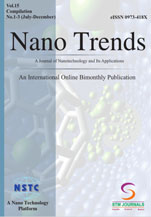
S. Anand,
- Professor, Department of Computer Science and Engineering Infant Jesus College of Engineering, Chennai,, Tamil Nadu, India
Abstract
‘]
This study provides an in-depth exploration of the rapidly evolving field of nanotechnology-based biosensors, emphasizing their significant impact on biomedical diagnostics. The integration of cutting-edge nanomaterials, including nanoparticles, nanowires, and quantum dots, has catapulted biosensing technology to new heights, yielding unprecedented gains in sensitivity and specificity, and revolutionizing the detection of biomolecules. The study highlights various types of nanobiosensors, including optical, electrochemical, and magnetic, each offering unique advantages for detecting specific biomarkers or environmental contaminants. The review covers recent advancements in nanobiosensors that enable early disease detection, which is crucial for timely medical intervention. It also addresses their growing role in point-of-care diagnostics, offering portable and efficient solutions for real-time health monitoring. Moreover, the potential of these technologies extends beyond healthcare, with applications in environmental monitoring for detecting pollutants and harmful chemicals. Future directions are explored, focusing on the development of more cost-effective, scalable, and robust nanobiosensors. Challenges such as regulatory approval, integration into existing medical infrastructure, and the need for large-scale manufacturing are discussed as barriers to broader adoption. Overall, the study emphasizes the transformative potential of nanobiosensors in both healthcare and environmental sectors, positioning them as pivotal tools in modern diagnostics.
Keywords: Nanobiosensor, nanoparticle, nanowire, optical, health monitoring
[This article belongs to Nano Trends-A Journal of Nano Technology & Its Applications (nts)]
S. Anand. Advances in Nanotechnology-based Biosensors: Enhancing Sensitivity and Specificity in Biomedical Diagnostics. Nano Trends-A Journal of Nano Technology & Its Applications. 2024; 26(02):26-32.
S. Anand. Advances in Nanotechnology-based Biosensors: Enhancing Sensitivity and Specificity in Biomedical Diagnostics. Nano Trends-A Journal of Nano Technology & Its Applications. 2024; 26(02):26-32. Available from: https://journals.stmjournals.com/nts/article=2024/view=175374
Fetching IP address…
References ‘]
- Sudharshan V Human like biosensor disease simulator, disease analyzer and drug delivery system. In 2013 IEEE Conference on Information and Communication Technologies, ICT 2013. 2013; 1033–1038.
- Ganji MR, Thakur M Microprocessor based biosensors for determination of toxins and pathogens in restricted areas of human intervention. In Proceedings of the International Conference on Artificial Intelligence, IC-AI’04. 2004; 1: 525–531.
- Eswaran U, et al. Design and Analysis of High Sensitive Microcantilever Based Biosensor for CA 15-3 biomarker detection. J Appl Sci Comput. 2018; 5(7): 682–698. ISSN: 1076-5131. DOI:16.10089.JASC.2018.V5I7.453459.0050021
- Eswaran U, Eswaran V, Murali K, Eswaran V. Application of sensors for smart farming. In: Khang A, editor. Agriculture and Aquaculture Applications of Biosensors and Bioelectronics. 2024. p. 18–44. doi: 10.4018/979-8-3693-2069-3.ch002.
- Huang Xiaohua, Ryan O’Connor, Elyahb Allie Kwizera. Gold nanoparticle based platforms for circulating cancer marker detection. 2017; 1(1): 80–102.
- Tagit Oya, Niko Hildebrandt. Fluorescence sensing of circulating diagnostic biomarkers using molecular probes and nanoparticles. ACS 2017; 2(1): 31–45.
- Farka Zdenek, et al. Nanoparticle-based immunochemical biosensors and assays: recent advances and challenges. Chem 2017; 117(15): 9973–10042.
- Maciel Edvaldo Vasconcelos Soares, et al. Miniaturized liquid chromatography focusing on analytical columns and mass spectrometry: A review. Anal Chim 2020; 1103: 11–31.
- Anklam Elke, et al. Emerging technologies and their impact on regulatory science. Exp Biol 2022; 247(1): 1–75.
- Ramalingam Murugan, et al. Impact of nanotechnology on conventional and artificial intelligence-based biosensing strategies for the detection of viruses. Discov 2023; 18(1): 58.
- Li Tie, Yue Li, Ting Zhang. Materials, structures, and functions for flexible and stretchable biomimetic sensors. Acc Chem 2019; 52(2): 288–296.
- Kulkarni Madhusudan B, Ayachit Narasimha H, Aminabhavi Tejraj M. Recent advancements in nanobiosensors: current trends, challenges, applications, and future scope. 2022; 12(10): 892.
| Volume | 26 |
| Issue | 02 |
| Received | September 2, 2024 |
| Accepted | September 11, 2024 |
| Published | September 24, 2024 |


